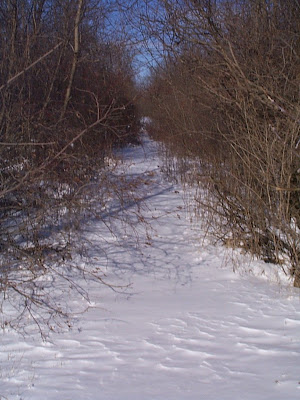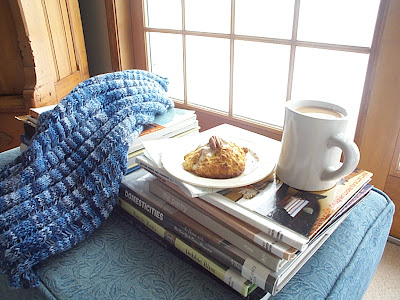Hard to believe it taken from the end of October to the middle of January for this blog to wade through the topic of "better bands and cuffs." Part of the time-span is because posts on other subjects sometimes broke in to derail the train of thought. Between taking so long and being interrupted with other subjects, it seemed wise to wind up this series by tying it together in a (hopefully) coherent way: the wrap-up which constitutes today's post.
The series starts with a prequel, and runs through 9 further posts, 11 total if you include the prequel and this wrap-up post. (Whew!)
The prequel to the series goes over knitted fabrics which don't curl:
GARTER,
SEED STITCH,
RIBBING and
DOUBLE MOSS STITCH.
The series proper starts with the post called
"Opera and soap opera" which offers an overview of the problem. This post introduces
NORM,
WANDA and
LON. Norm is a normal stitch--situated in the middle of a stockinette fabric. Norm is supported on all sides by his "sibling" and "cousin" stitches. These all share yarn so that stress leaves Norm literally unmoved--he is pinned in place and will return to shape when the stress (from a poking elbow or the like) is removed. Wanda is an edge stitch at the bottom of a sweater band. Stress makes Wanda wander: a stretch or a poke leaves her all ruffled because she has no support along the entire bottom edge: once she stretches, there are no sibling and cousin stitches among whom to distribute the stress and who can bring her into shape again. Lon is an edge stitch on a front band. Lon stretches out long when stressed, because, like Wanda, he has no support along the stretched out edge to pull him back into shape. The conclusion of the first part is that UNSUPPORTED EDGE STITCHES (Wanda and Lon) are the reason GARMENT EDGES RUFFLE and STRETCH OUT.
The second post (
Why cuffs and bands are wonky, and what to do about it) suggests a cure: If you KEEP THE EDGE STITCHES OF THE FABRIC AWAY FROM THE EDGES of KNITTED GARMENTS, the edge stitches can't stretch out. In Norm, Wanda and Lon terms, keeping Wanda and Lon away from the edge means that the edges are populated by Norm-type stitches: supported on all sides, these stitches can easily recover from the stretching stresses to which garment edges are subjected.
This part of the series also laid out the easiest way of keeping the edge stitches of the fabric away from the edge stitches of the garment: a
SIMPLE ROLLED STOCKINETTE EDGE.
The third part of the series discusses another method of keeping the edge stitches of the fabric away from the edge of the knitted garment,
making HEMS AND FACINGS. Again, this works because the edge of the garment is actually made up of Norm-type supported stitches--the Wanda- and Lon-type edge stitches are carefully tucked in on the inside where they are simply not subjected to the stretching stresses present at the garment edge.
The fourth part discusses how to
KNIT SHUT A HEM, either a rollover hem, or a hem with a fold line.
The fifth part discusses why knitting shut a hem is best on narrow tubes (socks, cuffs) but how knitted hems flip up on long seams like those at the bottom band of a sweater. The alternative to knitting shut is laid out:
SEWING SHUT A HEM.
The sixth part of the series changes direction away from strategies to keep unsupported edge stitches away from the edge of garments. Instead, this post accepts that sometimes the edges of the fabric will be the edges of the garment, and talks about how to stop such fabric/garment edges from flipping and curling. This sixth post also reaches back to the prequel post about non-curling fabrics such as ribbing, moss and garter. You see, the curling and flipping problem actually arises from
stockinette's severe tendencies to want to curl. Even when non-curling fabrics are attached to it, stockinette wants so desperately to curl that it simply takes the "non-curling" edge right along with it. This sixth installment shows how
STEAMING AND IRONING can help persuade stockinette away from this unruly behavior.
The seventh part also deals with stockinette edged with "non-curling" fabrics: this post lays out a way to knit single-layer fabric edgings which DON'T flip and curl (or at least, which don't flip and curl
as much):
ZIG-ZAG BANDS. Zig zag bands solve (or at least:
help solve) the curling-stockinette problem because the zig-zag pattern breaks up the fault line along which the stockinette wants to curl. The most common use for a zig-zag band is an improved method to attach a garter stitch edging to a stockinette stitch fabric, a scarf, for example, or the garter-stitch front bands of a stockinette sweater.
The eighth post in the series shows
TUBULAR CAST ON for a 1x1 ribbing--a method which controls the edge of a ribbing from spreading.
The ninth part lays out the matching
TUBULAR CAST OFF for 1x1 ribbing--a method which makes the exact same edge as the tubular cast on, only at the bound OFF edge.
These two posts--the tubular edge posts--really address a very specific bit of the overall wonky-band issue: the problem of controlling stretching in the very edge stitches of a ribbed fabric. Nevertheless, SO many garments are edged with an unhemmed ribbed fabric that the tubular cast-ON and tubular cast-OFF really might be the most useful posts of the whole series.
Tubular cast-on and -off are really spectacularly successful in turning "home-made" knitting into "handcrafted" goodness, and they both work because they stick a Norm-type stitch--a fully supported stitch--at the very, very edge of the ribbed fabric. In other words, we have completely eliminated Lon and Wanda type stitches, and we have turned them all into Norm-type stitches with these two nifty, nifty tricks. In the process, we have come full circle from the first posts to the last, and this is the end of "of the better cuffs and bands" series. Thank you for reading along!
One final thing: some readers have expressed interest in tubular cast ON and OFF for 2x2 ribbings (k2, p2). Although several methods are familiar to me, none are anywhere near as nice as the tubular cast on and cast off for 1x1 ribbing. I'll keep working away on this problem and will be sure to post if some new trick reveals itself.--TECHknitter
(You have been reading TECHknitting on: "Tricks for knitting better cuffs and bands, series review and summary)











 And, mine were not the only tracks through the snow today; the birds and animals have been out in full force as well, evidenced by all the footprints I saw circling in and out of the woods, across the ditch, and into the hayfield. The deer and rabbit tracks were easy to identify, but for the rest I have pulled out A Guide to Nature in Winter by Donald Stokes...
And, mine were not the only tracks through the snow today; the birds and animals have been out in full force as well, evidenced by all the footprints I saw circling in and out of the woods, across the ditch, and into the hayfield. The deer and rabbit tracks were easy to identify, but for the rest I have pulled out A Guide to Nature in Winter by Donald Stokes... ...which covers everything from winter weeds to snow crystals to bird nests and more. The pen and ink drawings are great...
...which covers everything from winter weeds to snow crystals to bird nests and more. The pen and ink drawings are great... I think I'll spend some time looking them over tonight. Have a great evening.
I think I'll spend some time looking them over tonight. Have a great evening.







